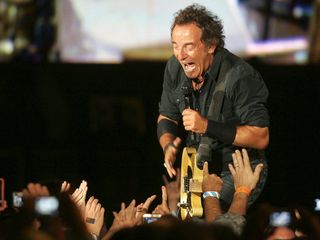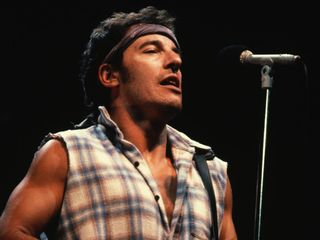Bruce Springsteen: The Promise album review track-by-track
Two CDs of unheard material from The Boss's Darkness On The Edge Of Town sessions

Introduction
In the introductory essay that forms part of the lavish packaging of The Promise: The Darkness On The Edge Of Town Story, Springsteen offers an insight into what was inspiring his music in the mid '70s: “I was still held in thrall by the towering pop records that had shaped my youth.”
That’s clearly evident among the 21 tracks we get to hear for the first time on the second and third discs of this release; a dizzying ride through American popular music, liberally borrowing instantly familiar motifs. The 10 tracks that comprised Darkness' on its release in 1978 were carefully chosen to reaffirm Springsteen’s literate singer-songwriter reputation, but the music here is less concerned with cementing a specific identity.
"'Darkness' was my 'samurai' record," Springsteen writes, "stripped to the frame and ready to rumble. But the music that got left behind was substantial." Having had three years to wait while management and legal wrangles prevented him from delivering any new music to the masses, Bruce nonetheless continued to record at Record Plant Studios in New York, not laying down working demos, but conjuring up fully-formed band recordings, many of which rank among his best work.
First up: Disc One: Racing In The Street

Disc One: Racing In The Street
The piano and harmonica are more pronounced in this embryonic version of the track that appeared on Darkness', giving the song a more sombre, hymnal feel, the E Street Band adding layer after layer of sound as the recording progresses.
It also differs by Springsteen changing key for the final verse, and making yet another lyrical allusion to the Martha & The Vandellas classic with which it almost shares its title (“calling out around the world” ).

Gotta Get The Feeling
A pounding, Spector-esque rocker with pronounced anglophile motifs - imagine a mash-up of The Four Seasons and Badfinger, all seductive chord changes and note-perfect harmonies. Instrumentally busy, and featuring one of Clarence Clemons’ most melodic sax solos, underpinned by what sound like mariachi horns.

Outside Looking In
Springsteen has never been shy about wearing his influences on his sleeve, and this track is centred on a galloping rhythm that recalls the Buddy Holly of Peggy Sue, right down to the abrupt ending.
Bruce’s voice is heavy on reverb, as he delivers one of his most poetic lyrics of unrequited love (“sins of the angels will haunt your pretty eyes”).

Someday (We'll Be Together)
An anthemic ballad, complete with sleigh bells and a thumping percussive backbone that recalls The Ronettes’ Be My Baby, as opposed to the Supremes hit that shares the song’s title.
Springsteen himself weighs in with an atmospheric guitar break that recalls the TV work of John Barry (shades of The Persuaders), while a massed choir boosts the euphoria of the chorus.

One Way Street
A slow-tempo soulful ballad which might just have easily come from the pen of Smokey Robinson, couched in a swirling and hypnotic Danny Federici organ.
The lyric finds Springsteen revisiting the same kind of lovers yearning for escape in Thunder Road, albeit less optimistically, their story conveyed with more than a few spiritual motifs, The Boss at one point rhyming “confessed” with “possessed”.

Because The Night
The Patti Smith hit, co-written by Springsteen, has long been a staple of his live show, but this early recording is even more powerful, building to an overwhelming crescendo.
Roy Bittan plays an elaborate counter-melody on the piano that occasionally hints at Mike Oldfield’s Tubular Bells, while Steve Van Zandt’s guitar break would appear to be half-borrowed from Blue Oyster Cult’s Don’t Fear The Reaper.

Wrong Side Of The Street
Springsteen nods to the garage pop of The Flamin’ Groovies and Shake Some Action on this metaphor-heavy rumination on a love going off the rails. Minor chords abound, but the highlight is a teasing guitar solo double-tracked note-for-note with an uplifting Clemons sax solo.

The Broken Hearted
The third (but not the last) allusion to Motown in a song title, although this moody country-tinged ballad is straight out of the Roy Orbison school, not least on the tear-stained falsetto at the end of each verse.
Bittan’s piano is to the fore again, creating an atmosphere of hopeless romantic loss. It’s a crime The Big O never got to record this himself.

Rendezvous
Bruce cranks the power pop dial up to 10 on this stage favourite. This version, recorded live in one take, is even more full of guitar jangle than the version which appeared on the Tracks box set, while Max Weinberg’s clatter-and-pound drums owe a sizeable debt to Keith Moon.
Springsteen’s breathless “Whoo!” at the end of the song suggests he knew this was a good ‘un.

Candy's Boy
Clearly a prototype of Candy’s Room, although the frenetic rush of the song that made it on to Darkness' is replaced by more delicate and melodic balladry, awash with '60s pop classicism; think The Turtles, or more specifically Tommy James & The Shondells’ Crystal Blue Persuasion.
The Federici organ takes centre stage again, beautifully cradling Bruce’s words about the wild girl he’s intent of saving from herself.

Disc Two: Save My Love
Not one of Springsteen’s most intricate songs, this paean to the promise of romance occasionally suffers from the nursery rhyme simplicity of the melody, making it sound like an out-take from The Partridge Family.
Don’t think it’s beyond salvation, though, as Roy Bittan’s chiming piano manages to lend the throwaway ditty a smidgen of E Street gravitas.

Ain't Good Enough For You
Finger-clicking upbeat soul that will register with any listeners familiar with This Little Girl, the 1981 hit Bruce wrote for Gary US Bonds.
It’s pretty much the same melody, but with entirely different words; a joyously danceable bar band workout, the massed E Street choir weighing in with some lusty call-and-response on the chorus.

Fire
Another longtime live favourite, this version has a slightly speedier tempo than previously heard Springsteen readings or the recording The Pointer Sisters took into the US Top Ten.
The instrumentation is minimal, punctuated by a scratchy Steve Van Zandt guitar part that suggests Steve Cropper on Booker T & The MGs’ Green Onions. Bruce, meanwhile, affects a pleasing reverb-heavy Elvis drawl that, appropriately, recalls Burnin’ Love.

Spanish Eyes
“Hey little girl, is your daddy home?/Did he go away and leave you all alone?” Bruce may have recycled the opening couplet for I’m On Fire years later, but here it raises the curtain on a powerfully bombastic country ballad, like The Eagles reimagined by Cecil B DeMille.
The E Street Band still play with all the East Coast blue collar verve we know and love, although the overall tone finds Springsteen exploring more mythical western motifs.

It's A Shame
Yet another title borrowed from a Motown classic (The Spinners this time), although its closest soulful cousin, considering the horn section backing, might be Otis Redding’s original recording of Respect.
Having said that, the opening riff and much of the melody was ultimately put to use on Prove It All Night from the Darkness' album. In this form, it’s a classic illustration of Springsteen’s ongoing love for 60s soul, Stax in particular.

Come On (Let's Go Tonight)
An early version of the song that appeared on Darkness' (with radically reworked lyrics) as Factory.
The tempo and sombre melody are the same, although the accordion and violin backing give it a more Celtic folk feel, its blue collar protagonists hoping to forget the hardships of their lives at “a party way down in Factory Town”. Another lyric pinpoints the date of the song’s birth: “The man on the radio said Elvis Presley died.”

Talk To Me
Horns aplenty feature on this urgent stomper that veers between old school ska and classic '60s beat group vibes.
This is the sound of Springsteen at his blue-eyed soul best, his voice curiously reminiscent of PJ Proby or Manfreds-era Paul Jones. Even the production sounds like it was put together in a low-fi two-track studio, and is all the better for it.

This Little Thing (My Baby Does)
An anthemic power ballad giving Bruce another chance to show off his impressive (but rarely used) falsetto.
The stirring chorus gives the song a singalong element that suggests it could have become a live favourite, had The Boss opted to unveil it earlier. Musically, Max Weinberg’s booming drums are the stars of the show, with Steve Van Zandt’s Byrdsian guitar breaks not far behind.

Breakaway
Another epic-like approximation of Roy Orbison, not least on the military-style drums that appear to be lifted straight from It’s Over. The lyric’s central characters, Sonny and Janey, may well be the same troubled souls who’ve cropped up in other Springsteen songs; desperate folk yearning for escape from a social wasteland of abandoned cars and crooked card games.
This is Springsteen at his most cinematic, fleshing out a feature film’s worth of emotion and incident in the space of five minutes of music.

The Promise
A companion piece to Breakaway, with Springsteen mapping out the mistakes he and his friends have made, stuck in a rut having “cashed in their dreams”. There’s also a clear connection to an earlier favourite, the chorus making frequent mention of Thunder Road.
Unusually for Bruce, the E Street Band is augmented by an understated string section that swells up in the second verse of a big-screen ballad that stays with the listener long after the song has finished.

City Of The Night
A slowburning soulful strut, arguably modelled on The Temptations’ My Girl, although the semi-sleazy plot of the imagery-laden lyric is perhaps closer to Lou Reed’s Walk On The Wild Side - how’s that for a clashing of influences?!
It’s a fascinating juxtaposition, the sweetness of the melody barely disguising the dark underbelly of the words.

Verdict
While the vast majority of deluxe reissues of classic albums are inevitably padded out with crude demo versions, misfiring remixes and so-so live tracks, Springsteen delivers a stunning collection of songs which, had they emerged as an album in their own right in 1976 or '77, would clearly have garnered as much critical acclaim as those it followed and preceded.
Arguably, the “jukebox” approach of acknowledging myriad bygone influences is something he would return to on 1980’s The River, but here, more so than at any other time in his career, Springsteen is raising a glass to the music that inspired him and the E Street Band in their lean and hungry pre-superstar years.

"Reggae is more freeform than the blues. But more important, reggae is for everyone": Bob Marley and the Wailers' Catch a Fire, track-by-track

“Part of a beautiful American tradition”: A music theory expert explains the country roots of Beyoncé’s Texas Hold ‘Em, and why it also owes a debt to the blues

"Reggae is more freeform than the blues. But more important, reggae is for everyone": Bob Marley and the Wailers' Catch a Fire, track-by-track

“Part of a beautiful American tradition”: A music theory expert explains the country roots of Beyoncé’s Texas Hold ‘Em, and why it also owes a debt to the blues
Most Popular









